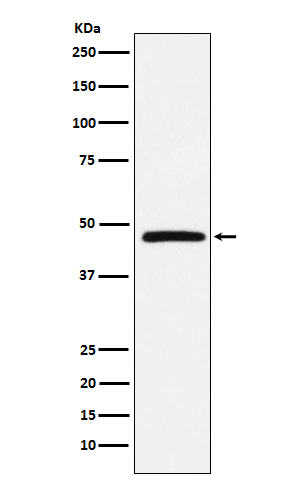
| WB | 1/1000-1/2000 | Human,Mouse,Rat |
| IF | 1/20-1/50 | Human,Mouse,Rat |
| IHC | IHC:1/100-1/200;IHF:1/50-1/200 | Human,Mouse,Rat |
| ICC | 1/50-1/200 | Human,Mouse,Rat |
| FCM | 1/20-1/100 | Human,Mouse,Rat |
| Elisa | 咨询技术 | Human,Mouse,Rat |
| Aliases | CCBP1; CD234; DARC; Dfy; FY; GPD; GpFy; WBCQ1;;Atypical chemokine receptor 1 |
| WB Predicted band size | Calculated MW: 36 kDa ; Observed MW: 35 kDa |
| Host/Isotype | Rabbit IgG |
| Antibody Type | Primary antibody |
| Storage | Store at 4°C short term. Aliquot and store at -20°C long term. Avoid freeze/thaw cycles. |
| Species Reactivity | Human,Mouse |
| Immunogen | A synthesized peptide derived from human Atypical chemokine receptor 1 |
| Formulation | Purified antibody in PBS with 0.05% sodium azide,0.05% BSA and 50% glycerol. |
+ +
以下是关于DARC(Duffy抗原/趋化因子受体)抗体的3篇代表性文献,涵盖其在不同疾病中的研究:
---
1. **文献名称**:*Duffy antigen receptor for chemokines is essential for the neutrophil response to murine kidney ischemia-reperfusion injury*
**作者**:Lee, J.S., Frevert, C.W., Wurfel, M.M., et al.
**摘要**:研究利用DARC抗体探讨DARC在肾脏缺血-再灌注损伤中的作用,发现DARC通过调控中性粒细胞趋化因子(如CXCL1和CXCL2)的清除,影响炎症反应和组织损伤程度。
---
2. **文献名称**:*The Duffy antigen receptor for chemokines (DARC) regulates prostate tumor growth*
**作者**:Shen, H., Schuster, R., Stringer, K.F., et al.
**摘要**:通过DARC抗体阻断实验,发现DARC通过结合促血管生成趋化因子(如IL-8和CXCL1),抑制前列腺癌的血管生成和肿瘤生长,提示DARC在癌症治疗中的潜在靶点作用。
---
3. **文献名称**:*The Duffy antigen/receptor for chemokines (DARC) regulates Plasmodium vivax invasion in human erythrocytes*
**作者**:Miller, L.H., Mason, S.J., Dvorak, J.A., et al.
**摘要**:经典研究证实DARC是间日疟原虫入侵红细胞的受体,利用抗DARC抗体可阻断疟原虫感染,揭示了DARC阴性人群对间日疟的天然抵抗力机制。
---
**备注**:DARC抗体研究多聚焦于其双重角色——作为趋化因子“清除剂”调控炎症,以及作为病原体(疟原虫、HIV)的感染受体。上述文献分别从炎症、癌症和传染病角度提供了关键证据。
The Duffy Antigen Receptor for Chemokines (DARC), also known as ACKR1 or CD234. is a transmembrane protein first identified in 1950 through studies on blood group antigens. It belongs to the atypical chemokine receptor family, lacking classical signaling activity but acting as a scavenger or decoy receptor. DARC is expressed on erythrocytes and endothelial cells, where it binds pro-inflammatory chemokines (e.g., CXCL1. CXCL8) and Plasmodium vivax malaria parasites.
The DARC gene exhibits a well-known polymorphism: many individuals of African descent lack erythrocyte DARC due to a promoter mutation (FY*BES), conferring resistance to P. vivax infection. This adaptation reflects evolutionary pressure from malaria-endemic regions. Beyond its role in malaria susceptibility, DARC regulates chemokine homeostasis, influencing inflammatory responses, angiogenesis, and tumor progression.
DARC antibodies, targeting extracellular epitopes, have research and clinical significance. They are used to determine Duffy blood group status in transfusion medicine, study malaria invasion mechanisms, and investigate DARC's immunomodulatory functions. Anti-DARC therapies are explored for conditions like cancers and inflammatory diseases, though clinical applications remain experimental. Recent studies also link DARC expression to HIV pathogenesis and COVID-19 severity, highlighting its multifaceted role in human health.
×